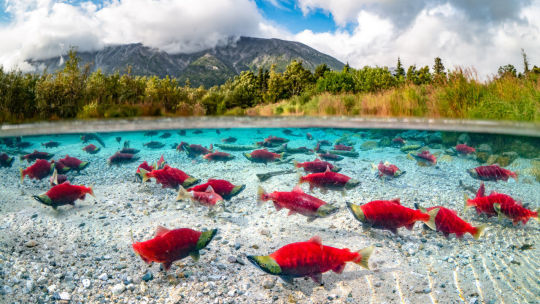#otolith salmonextinction wildsalmon
Text
The Biological Development of Salmon Is Ancient
October 1, 2019 (Tokyo, Japan) - This is a super article published by Science Magazine on salmon in Alaska related to what causes these sockeye salmon after 2 to 5 years living in the ocean to return to the same place where they were spawned to mate and die. The point here is that farmed salmon will not be capable of developing a fully capable otolith located just behind their brain. It’s like we are witnessing the intentional destruction of salmon with Alaska being one of the last locations wild salmon have been forced to live. As you can see from this article, salmon don’t stand a chance against the parasitical creature called “man.”
________
Source: Science Magazine
How a salmon scientist got hooked into a battle over the world’s largest gold mine
By Warren Cornwall | Sep. 26, 2019

Sockeye salmon wait to spawn in Alaska’s Lake Iliamna, which helps produce about 20% of Bristol Bay’s salmon. The Pebble Mine would sit in the lake’s headwaters.
It's hard to think small in Alaska. The largest of the United States is home to North America's highest mountain range. It's a place where undammed rivers run more than 1000 kilometers, glaciers collapse into the ocean, and polar bears roam.
Daniel Schindler, however, is here hunting for something the size of a grain of rice. Crouching in tiny Allah Creek, hemmed in by alders and smeared in blood, he grasps a rotting sockeye salmon carcass and nearly decapitates the fish with a stroke of a carving knife. With tweezers, he delves into a cavity of creamy goo tucked behind the brain and plucks out a sliver of what looks like bone. It is an otolith, a bit of calcium carbonate that sits within the inner ear and acts like an internal gyroscope, helping the fish orient its movements.
Schindler, an aquatic ecologist at the University of Washington in Seattle, holds the white fleck up to the sunlight. "For some reason, picking otoliths is a very therapeutic activity," he says, as a cluster of scarlet-sided sockeye thrashes by in the shin-deep water, frantically searching for their spawning grounds.
Chemical isotopes trapped in the otolith, which forms layers like tree rings as it grows, tell the story of the salmon's birthplace and life. Between 2 and 5 years ago, the sockeye hatched in this creek, a tiny corner of the sprawling network of freshwater lakes and streams along Alaska's Bristol Bay. The fish headed out to sea and finally returned to its birthplace to spawn and die.
Over the past 2 decades, Schindler and colleagues have used otoliths and other data sources to illuminate how Bristol Bay consistently sees tens of millions of returning fish, year after year, making it one of the world's most productive and lucrative salmon fisheries. The work has become a classic among ecologists, earning more than 1000 citations. Now, it has thrust Schindler into one of the biggest environmental battles of the early 21st century. A mining company wants to extract copper and gold from a massive ore deposit beneath headwaters of two of Bristol Bay's main salmon rivers. The Pebble Mine could become one of the world's biggest mineral producers, with an open pit nearly as deep as the Grand Canyon and vast infrastructure and waste piles that would stretch for kilometers.
Opponents of the project, including Native Alaskan, fishing, and environmental groups, have long argued that the mine's short-term economic benefits would pale in comparison with the long-term risks to Bristol Bay's salmon runs, including toxic runoff and habitat destruction. Critics have seized on Schindler's science to help make their case, and in 2014 the findings helped persuade then-President Barack Obama's administration to move to block the mine. But this year, President Donald Trump's administration signaled it might allow the project as part of its efforts to encourage development.
Please go to Science Magazine to read the entire article.
________
Related:
Chemical tags in ear bones track Alaska’s Bristol Bay salmon
0 notes